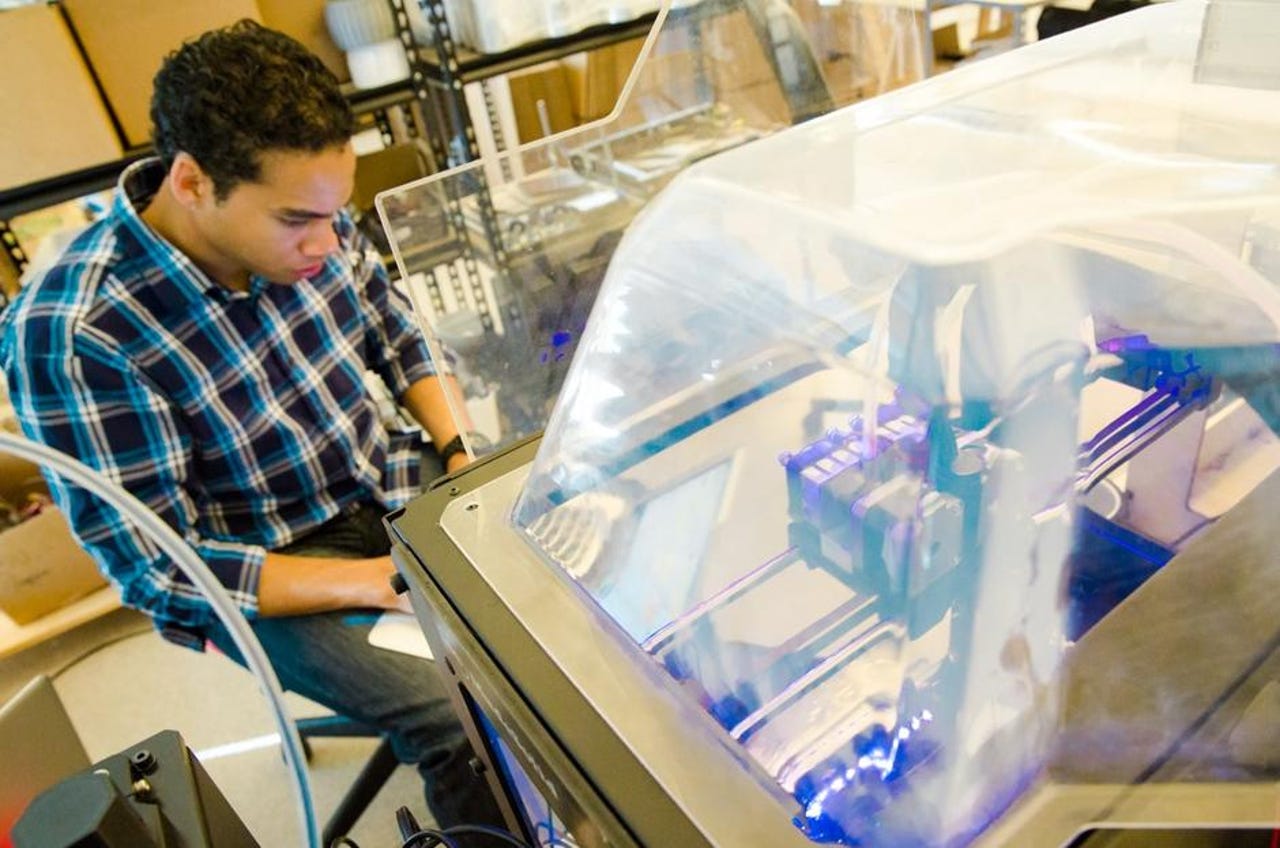How 3D printing is building a new future


3D printing has recently emerged as tech's topic with the greatest expectations. It gets touted as the innovation destined to transform nearly everything, from manufacturing to medicine to entrepreneurship.
Technically, 3D printing, or additive manufacturing, refers to the process of creating almost any three dimensional object with various materials such as plastic, metal, or carbon fiber. For the past three decades, 3D printers were primarily used by engineers for rapid prototyping.
With the rise of low-cost 3D printers in recent years, the technology has turned into a movement and a catalyst to disrupt industries, businesses, and conventional ways of doing lots different things from buying replacement parts to designing your own custom jewelry and accessories.
Not only is 3D printing quickly becoming popular with the average consumer and small business owner, and unleashing a whole movement of entrepreneurial makers, it is also changing the way big-name manufacturers like Boeing and General Electric build their products. The two companies now use 3D printers to make dozens of parts for airplanes and jet engines, for example.
Desktop 3D printers are one of the fastest-growing categories on crowdfunding sites like Kickstarter — and some of the most highly funded campaigns. They are now available for purchase through commercial retailers like Home Depot and on Amazon, and have become a fixture in hackerspaces and startup offices across the planet.
In 2013, Gartner reported 49 percent growth of 3D printers under $100,000. It was the first time the research firm analyzed data regarding that area of the market. For 2014, analysts predicted 75 percent growth. Another report, published by Allied Market Research, predicts the global 3D printing market will reach $8.6 billion by 2020.
Even more recently, Gartner predicted the technology will reach mainstream adoption in both enterprise and consumer markets within ten years. The reality is that it could happen even sooner in specific markets such as manufacturing and medicine. Still, there are still hurdles the 3D printing industry must overcome first, including things as simple as energy usage and the materials used — which is most commonly unreliable plastic — and as complex as intellectual property issues.
As with any exciting new technology, the hype often clouds our judgment about where the state of the industry actually lies. Before we get a desktop 3D printer that we imagine to be a Star Trek replicator, let's step back and put it into perspective.
States of disruption
In January 2009, Bre Pettis badly wanted a 3D printer to begin making things, but he couldn't afford one. So Pettis and his team decided to make one on their own, which produced the MakerBot Replicator.
"When we started, 3D printers were in academic institutions and high-end design studios. And we just thought everybody should have one — that this should be on every single desktop, and everybody should have access to a MakerBot and be able to make things they need," Pettis said.
Since 1983, when Charles Hull, the co-founder and CTO of 3D Systems, invented stereolithography (SLA) printing, 3D printers have largely been out of reach for the majority of the population.
Since engineers were, for the most part, the only people who utilized the computer-aided design (CAD) software that you needed to create 3D printed objects, 3D printing remained little more than a specialized tool in a highly specialized profession for its first two and a half decades. There were a few exceptions like Ford Motor Company, which has used 3D printing technology since the 1980s, and academic institutions with high-end additive manufacturing labs like the University of Louisville in Louisville, Kentucky.
Now, both large and small-scale companies realize they can make a relatively modest investment into 3D printing technology so they can prototype products, make small parts, and use alternative design technologies that were not possible previously, according to Pete Basiliere, the lead 3D printing analyst at Gartner.
"3D printing frees up the engineer and creative person in the market or an organization from the shackles of the traditional technologies," he said.
Manufacturing isn't the only industry benefiting from the technology. The medical industry is also rapidly growing its use — in particular, dentistry, which uses 3D printing to simplify the orthodontic process by designing and printing molds. Bioprinting is also quickly becoming more popular, with companies like Organovo testing printed organ tissues. Startups in the food industry are also experimenting with the technology, testing 3D-printed meatless meat to help reduce carbon footprints for example, and using 3D printing to better understand the nutritional makeup of food.
No-one has figured out the precise recipe for bringing the desktop 3D printer to the masses. Part of that is because no traditional printer companies have entered the market — despite HP's grand promises. Today's major players are Stratasys, which now owns MakerBot, and 3D Systems, which sells its desktop 3D printers under the Cube brand. Both companies have built partnerships with manufacturers like BMW, Hasbro, and Hershey's to mark territory before HP enters.
All this has left the market ripe for growth — which is where crowdfunding has stepped in. The machines are some of the most highly funded projects of all time
- Form1, a desktop 3D printer, raised $2.9 million in 2012.
- The Micro, a 7x7 desktop printer, raised $3.4 million earlier this year.
- 3Doodler, a 3D printing pen, raised $2.3 million in 2013.
- Buccaneer, a desktop 3D printer, raised $1.4 million in 2013.
"On the consumer side of the market, it's very clear now we're talking into the hundreds of outfits trying to provide low-cost, consumer-oriented 3D printers. That in theory is good for consumers because it starts to bring 3D printers to a price that is more appealing to consumers as opposed to early adopters and hobbyists and makers," Basiliere said.
Also popular with consumers is 3D printing's open source roots. Websites like Shapeways and Thingiverse offer a place for anyone to upload and share designs, and the platforms have laid the foundation for a creative community.
Shapeways' team has increased two-fold since last year, and it now makes 130,000 parts on a monthly basis. About 120,000 designs are uploaded every month by users. More than 15 materials, including various colors of plastics, metals, and precious metals like silver and gold are available to print. Shapeways currently has two offices: New York and the Netherlands, and CEO Peter Weijmarshausen said he plans to grow the company in the coming years.
"What I'm surprised by is the creativity of our community," he said. "When you give people the freedom to create what they want, it's completely mind blowing...give people freedom, and they will do it."
The major obstacles
A major hurdle for 3D printing is the overall ecosystem, which hasn't matured yet. Although communities have sprouted up online, they're not popular or convincing enough to take the technology mainstream. And even if there are getting close to a hundred options for 3D printer models, they're not still compelling or intuitive enough for a broad enough audience to use on a regular basis.
Many of the crowdfunded models will not all have viable business models, and most of them will probably disappear over the next few years.
"Consumers are going to get the idea that they can buy this kind of device and find that the provider is going to be with them for a long time," Basiliere said. "Many of those companies are going to be...scrapped for funding for additional development."
These desktop printers, whether they're crowdfunded or sold by major retailers, are not yet fully functional or affordable, which will hold the industry back from gaining ground in the consumer market. For instance, the smallest version of a MakerBot is the Replicator Mini, which runs at about $1,400.
TechRepublic recently bought one of these for the office, set it up on a desk, hooked up the software, and pressed print. No dice. Turned out the software was clunky and the extruder head didn't work correctly, so we returned to Amazon and ordered a new one. That machine's drive belt was severed upon arrival and so it was unusable as well and is now on the way back for a second replacement unit.
It's only one particular instance, but it goes to show that 3D printing hasn't totally arrived yet. The software is still confusing and is often not compatible between makes and models; the machine itself doesn't work if you simply hit 'print'. The 3D printers also hog energy, waste plastic, and make more noise than a copy machine.
SEE: The dark side of 3D printing
"The major inhibitor in the consumer market is that [there is] no compelling application to encourage a person to buy one or bring it into the home. If you're a hobbyist or person who has means to invest in expensive new gadgetry, certainly you'll buy. The reality is, after you've done modeling and made some gifts, you can buy the equivalent online or at a physical store," Basiliere said.
But the growth of this market as a whole is far outpacing any regulations for it. On Shapeways and Thingiverse, users can design and download basically anything they want, from Star Wars characters to Google Glass accessories. Tweak, share, and sell the products — the designs are free, and right now, it's all legal (or, at least the legal ramifications are still a gray area).
Weijmarshausen said Shapeways does not allow copyrighted material to be distributed on the site, but that's only one slice of the pie. No-one can control what people design and print at home, and only time will tell how companies handle this issue. Some are trying to build partnerships with 3D printing services to allow for experimentation with patents and designs in order to stay ahead of the game.
The promise of 3D printing
Imagine loading a 3D design for a replacement part on your USB and taking it to a service bureau — something like Kinko's — to print it out. This is the ultimate promise of 3D printing: that one day soon, it will make things that simple.
But first, 3D printing needs to be appeal to a wider audience. Even with the hype, the community is still mostly made up of makers and hobbyists, though Basiliere said Gartner predicts there will be a compelling application for having one in the home by 2016.
"It needs to be easy to use, affordable, and relevant. The marketplace on Shapeways where the designers build their own businesses and bring really cool products to market, this is how we inspire people. I think that inspiration is what will bring 3D printing to the forefront, making it much more relevant for a much broader audience," Weijmarshausen said.
Service bureaus could bring this technology full circle, he added. When Shapeways started, there were 3D printing bureaus because the machines were too big to fit inside a home, but the facilities never really caught on. Since most people are still on the fence about buying their own, service bureaus could offer an attractive alternative.
This week, Amazon announced the addition of a 3D printing store on its website, where people can customize and order products. Right now, the list of goods is short, but it proves the retailer is betting that 3D printing is here to stay. It may be the start of this service bureau trend, and it may be the start of mass adoption. Time will tell.
So far, it has proven difficult to predict how the world will react to 3D printing. It's opening up a new world of creativity for the average consumer, a new paradigm for manufacturing, new opportunities for entrepreneurs, and new issues for lawmakers, all of which are confusing to navigate. One thing, however, is fairly certain: 3D printing is poised to be the epitome of a disruptive technology.